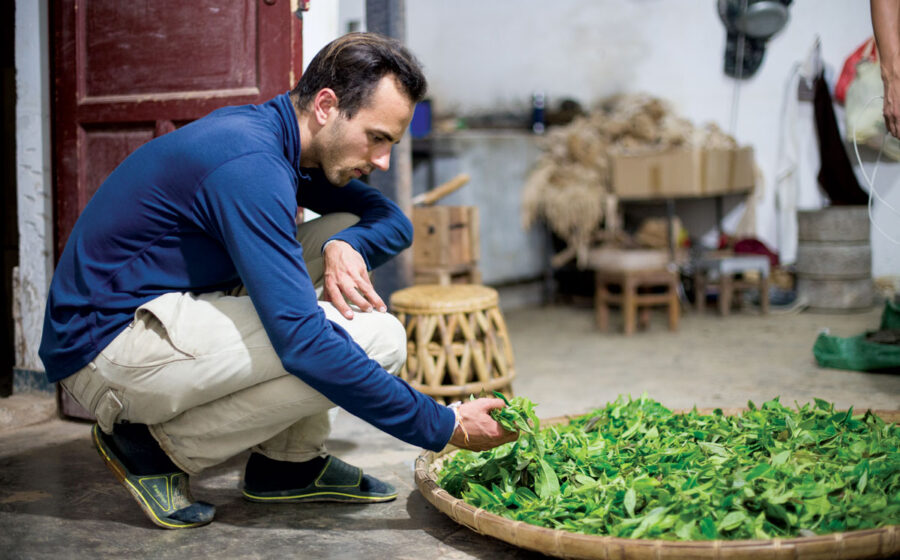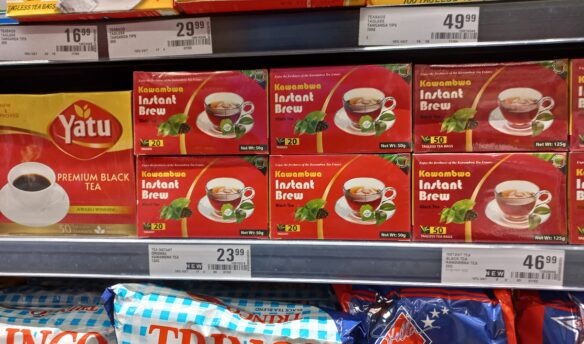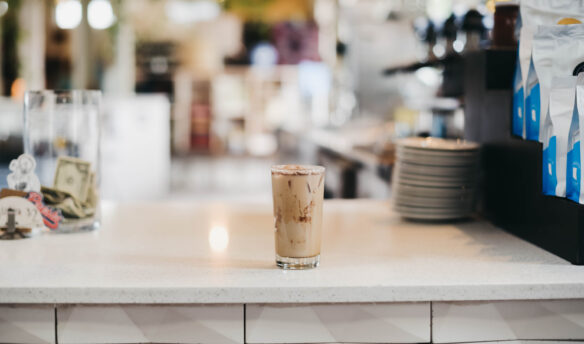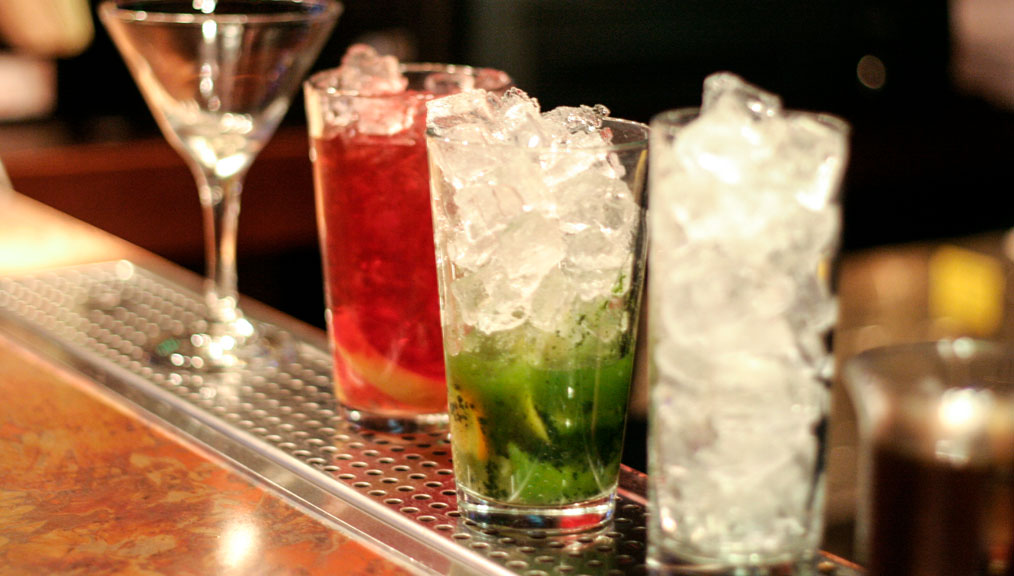[I]t’s September, the autumn harvest if you live in Xishuangbanna, China, or any tea village. I wake early to the smell of tea leaves roasting on a wok outside the window. The sun is not yet up, but Liu Bin is, and he’s roasting yesterday’s harvest of about forty pounds of fresh pu-erh. Each morning when we wake, we begin work. When the work is complete, at the end of a long day, we join friends to eat and drink around big, round tables full of food.
I lift myself out of bed and button up my shirt. I have slept here for months. During harvest season I share this room with thousands of pounds of finished leaves. The only way to smell something from the outside is if it is somehow more potent than the delicious smell of these leaves. But nothing really is.
Liu waves to me as I make my way down the dirt path towards the woks.
“Are you hungry?” he asks without looking up.
“No, I am here to help.”
Five pounds of tea dances on the wok, between his fingers, and up to the edges of the pan then gently back to the center. Watching him, you would swear it is in fast forward.
The wood under the wok pops loudly, the crackling of the burning wood singing with the crackling of the leaves. We are in the kill green stage of tea production where the tea has been left to wilt for hours, and now it is time to halt that process, roast out more of the moisture, and allow enzymes to be pulled out from inside the leaf cells. This may be done at any time of day, but the cool morning is best, and the daytime is better for picking when working with only a small family operation.
The leaves are tossed and turned around the wok, which is big enough to take up a whole card table; then, at the most precise moment, Liu stops. Suddenly the leaves are collected and rolled into a large ball, looking almost like frozen spinach that’s been removed from its box and thawed. The ball is quickly placed onto a bamboo tray the size of the wok, then rolled vigorously.
Five pounds of tea dances on the wok, between his fingers, and up to the edges of the pan then gently back to the center. Watching him, you would swear it is in fast forward.
If you have seen someone cook on a wok at a Chinese restaurant, that is similar to the motion that takes place when firing tea. If you have seen someone kneading bread dough, the motion of the rolling process is very similar. The mastery involved, and the instinct that is present in these men and women, is as if from somewhere within their DNA.
Tea is made by peasants and businessmen and masters and children. Tea is consumed by peasants and businessmen and masters and children. There is something in all of us that is more balanced when we drink great tea, especially a great raw pu-erh, as we are making here. Pouring this tea for anyone brings about a change so profound that it can only be explained by pointing to the tea. It is used as a medicine, as a guide, as a beverage, and as a tool. That is exactly why it is so important to prepare it with the skill of a master.
After a minute of rolling the tea, it is covered for a moment with a tarp and carried to the deck where it will spend much of the day soaking up the sun. I grab the bamboo basket with the tea and follow Liu, who is drinking mi zhou, or rice congee. We make our way up the steps to the deck to place the tray where it can dry.
We kneel at an empty space and set down the tea, then open the tarp to let the leaves settle. It is still very hot and the smell is strong enough to permeate our clothes for weeks. I toss the tarp to the side and we begin to gently separate the tea from itself and spread it across the basket.
The sun is coming up now and I can see a handful of other trays full of tea spread throughout the deck. Liu must have been up for hours.
We enter a second room in the factory where the tea is steamed and compressed into various shapes, most often the shape of the moon.
I grab a handful of the tea from the ball and lift it above my head, then drop it, watching it glimmer as it falls from my fingers. I was taught this only by watching, and it is clear that it allows the leaves to spread more evenly and, eventually, dry more evenly. In order for a tea to legally be called pu-erh tea, it must be sun-dried, giving it what the villagers call the taste of the sun. It also must come from this region and it must be picked from the large leaf asssamica variety of the Camellia sinensis plant.
Once the tray is about two or three leaves thick and covering all of the bamboo, Liu nods and we grab the tarp. “You want to eat pizza today? We will go to the city,” Liu says as we make our way back down.
I laugh, “Of course.”
Liu, like many people in Asia, is almost sure that pizza is American and, being that I am from America (although my family is from Italy), I must like pizza. Years ago, I introduced Liu and his friends to pizza when we went into the city, about a four-hour car ride away. He has shared so much with me, I wish I could show him something better. To them, tea is life, it is the only drink, besides maybe rice wine. It is not trendy or Buddhist or spiritual, it is first and foremost a necessity to life.
We head towards my bedroom in the small three-room tea factory where tea is stored and grab a large bag filled with yesterday’s harvest. This bag is marked thirty kilograms and smells no different than how I imagine the village when I am away from it.
The tea in the bag is complete, yet there is a final step that it can go through, if the buyer wants it that way. Pu-erh is unique in this way. It comes in many shapes and forms and there are three types of pu-erh tea. The first is what we have here and all that the family produces, raw (sheng) pu-erh which is green and tastes most like the green leaf. The second is the same tea just aged, (called lao sheng pu-erh), known for its rich flavors and its ability to mature over time and increase in value. The third is ripe (shou) pu-erh tea which is an artificially aged pu-erh that is most often a much darker, often black, leaf and liquid that was first created to replicate the taste of the naturally aged pu-erh.
We enter a second room in the factory. This room has another wok and stacks of fifty-pound stones with handles on top of them. This is the room where the tea is steamed and compressed into various shapes, most often the shape of the moon.
The process is very simple. Water is added to the wok, a lid with a small hole in it is put over that, then a canister full of tea is put over the hole so that the tea is steamed and made very malleable. Once the tea is steamed, it is put into a canvas bag the size of a small T-shirt, then one of the large stones is placed over it and one of us stands on the stone to compress the tea. With that, you have a bing, or compressed tea. Being that it does go through a steaming process, which wets and heats the leaves, it is slightly different in flavor than if it had been left loose-leaf.
It is, first, out of necessity that many of the traditions we have today were developed. Eventually, it becomes culture and habit that keeps us with them. Pu-erh was first compressed to allow for easier shipping of a much larger amount of tea. In the past, horses and porters would carry maybe thirty to sixty kilograms of loose tea on their backs, but once compressed into discs and bricks, they could now carry as much as 200 kilos. One of the bings the family presses has 200 grams of tea and can fit in a hand; yet, when that tea is loose it would take a backpack to hold all the leaves.
Liu and I grab a few boxes of compressed tea, each box holding forty-two bings, and toss it in the back of his truck parked out front. We then grab two of the bags of tea we harvested this week. We are heading to the city to make a shipment of tea to America to supply one of the teahouses that carries Misty Peak Teas, my company. We must leave right away because the post office is nearly four hours away.
Liu locks up and we head for the truck. He hands me a bottle of warm rice congee and he turns on the music.
Not long ago, within some of the villagers’ lifetimes, this would have never been possible. Sixty years ago, few Westerners were wandering in small tea villages across the world. This is why pu-erh and many teas are still so unknown in the West, even to many tea enthusiasts.
It is this travel and labor by producers and purveyors that gets tea to doorsteps across the world. Porters and horsemen and peasants and nomads worked thousands of years in this land, carrying tea from those storerooms to distant villages or palaces. If the receiver had money in his hand, he could have the tea. Now, thanks to technology and education, if someone has money in her hand and access to the Internet, they will have tea, no matter their town or country. With the efforts of tea purveyors, no longer are the days when only the rich or royal drink great tea.
Access to the source of tea is now easier for purveyors. With new roads being built in just the past few years, the ride to the city is less tiresome than before. Post offices are popping up in more of the small villages, and porters, now driving small trucks instead of horses, are available to carry tea for you from the farm to the city, and even to the post office.
While many tea shops in the West are buying from wholesalers who buy from wholesalers, there are a select few who have a bed waiting for them in a tea storage room somewhere. This connection to producers enhances the experience of enjoying our commodities, and our ability to tell the story of tea, its region, and its people. Once that is lost, much is lost with it. There are two major movements in the West right now: the big box store movement and the natural foods store movement. Some give no mind to the origin of their teas, but others love to feel the connection of supporting a family and knowing a product was made with care. The closer the consumer is to the producer of a tea, the more accessible the producer is to be available for questions or information or to simply be told, “thank you.”
We are in an age where getting tea has become easier and easier, but getting great tea at a reasonable price is becoming more difficult than ever because the desire for great tea is surpassing the supply of great tea in the world. As great tea is discovered, then sold, it eventually has the risk of being mass-produced. There are countless villages that became townships that became cities, all because of the caravans of tea purveyors and drinkers that flock to those mountains. The individual tea farmer often folds himself into a part of the local tea community, allowing his tea to be produced or processed by the local factory, thus standardizing the taste and often, unfortunately, losing the craftsmanship and quality. The more we demand great tea and educate ourselves on what exactly that is, the more we direct our shops and suppliers to provide it for us, and to seek out that craftsmanship. Just as the world is being informed that pizza is American, there are many that are telling people that tea is supposed to be sweet with flowers and chocolate in it, or that pu-erh can be picked in India.
Liu rolls down the window and turns up the music once again. I roll down mine, to let in the fresh air from the mountains, and listen to the bags in the back of the truck working their way through the wind. Years ago, I used to have to fill my suitcases with tea and pay for others to come with me so that I could fill their suitcases. The cost of shipping 100 pounds of tea on an airplane is almost as much as getting another airplane ticket, so I welcomed the company and the extra hands.
Now, we set the post office into our GPS and will wrap the bags very tightly so that the smell of whatever others are shipping will not get into our precious cargo. The flight back home for myself will be about forty-five hours, and the tea will show up a few weeks after that, I hope. Customs will be paid when it arrives and the FDA stamps and forms will be stuffed into each box.
I know it is pure fate that brought me here. I was lucky enough to meet this family as I walked through their village looking for great tea and maybe a few photos. They grew something that we don’t have back in America, and I wanted to be a part of that. Maybe I had something that they didn’t have within their own village that they wanted from me as well. Purveyors, like myself and so many, will continue to travel the world looking for the next best tea leaves or coffee beans, in hope of finding find a great supplier or, even more luckily, a friend.
—Nicholas Lozito is the owner of Misty Peaks Teas.





















